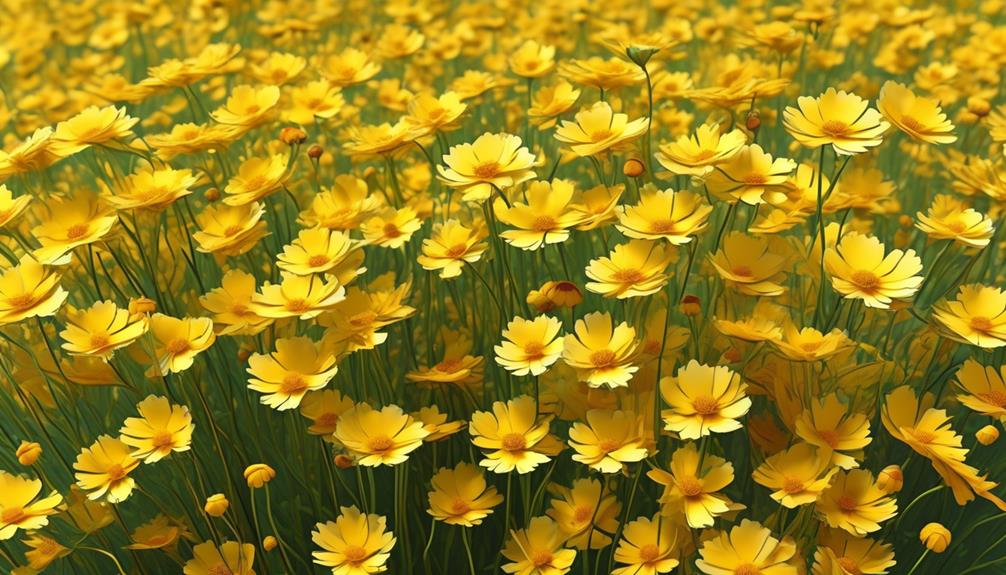Imagine stepping into a garden where time seems to stand still, where the air is filled with anachronistic whispers of positivity and hope.
Welcome to the world of Coreopsis, where the cheerful blooms of optimism await you. These vibrant and resilient flowers, with their sunny hues and delicate petals, have the power to uplift and inspire.
But there's more to these blooms than meets the eye. Join us as we explore the fascinating world of Coreopsis, uncovering the secrets behind their joyful presence and discovering how they can bring a sense of brightness to your own life.
Blooming Beauties With Positive Vibes
Blooming with vibrant hues and radiating positivity, the cheerful blooms of Coreopsis are sure to uplift any garden or floral arrangement.
Coreopsis plants, also known as tickseed, are native to North and South America. With their wide range of colors, including yellow, gold, pink, white, peach, red, and burgundy, these flowers attract bees, butterflies, and birds while being mostly deer-resistant. They thrive in full sun and well-drained soil, making them perfect for the Spring season.
Coreopsis grandiflora, a popular species, has large flowers that add a burst of color to any landscape. These plants are low-maintenance and drought-tolerant, requiring minimal care. Additionally, they benefit from deadheading to encourage reblooming, making them a great choice for those looking for long-lasting blooms.
Story and Origins
With its vibrant colors and ability to attract pollinators, Coreopsis has a fascinating story and origins that add depth to its cheerful blooms.
Native to North America, Coreopsis belongs to the genus of flowering plants and is commonly known as tickseed. There are two main species of Coreopsis: Coreopsis grandiflora and Coreopsis verticillata. These native plants have a wide range of bright colors and are a valuable addition to any garden.
With its early summer blooming period, Coreopsis is typically an annual or perennial species with a low-maintenance growth habit. It thrives in full sun and well-drained soil, making it a popular choice for gardeners.
Whether planted in early spring or fall, Coreopsis will reward you with its beautiful, long-lasting flowers.
Colorful Symbolism
Coreopsis flowers, with their vibrant colors and rich symbolism, bring a burst of joy and optimism to any garden. These cheerful flowers, native to North and South America, thrive in full sun and are known for their daisy-like flower heads. Coreopsis species typically bloom in shades of yellow, orange, pink, and red, each carrying unique symbolic meanings. To engage your garden with colorful symbolism, consider incorporating the Lil Bang or Big Bang series of Coreopsis, which offer a variety of bright hues. These vibrant blooms not only add a bold and eye-catching element to your garden, but they also make excellent cut flowers, perfect for creating arrangements that represent positivity and cheerfulness. Embrace the vibrant beauty of Coreopsis to infuse your outdoor spaces with uplifting and vibrant symbolism.
| Coreopsis Facts | Symbolic Meanings |
|---|---|
| Native to North and South America | Joy and happiness |
| Thrive in full sun | Optimism and positivity |
| Vibrant daisy-like flower heads | Sunny disposition and cheerfulness |
Coreopsis Represents Joy and Happiness
To continue exploring the vibrant symbolism of Coreopsis flowers, let's now focus on how they represent joy and happiness in gardens and landscapes.
Coreopsis, also known as tickseed, is a plant that brings pure happiness with its cheerful blooms. The yellow flowers of Coreopsis, in particular, symbolize joy and can instantly brighten up any garden or floral arrangement.
These vibrant blooms thrive in full sun and can last longer than many other flowers, spreading happiness throughout the season. With lance-shaped leaves and a preference for well-drained soil, Coreopsis is a low-maintenance plant that effortlessly brings joy to any garden.
Whether you're a seasoned gardener or just starting out, including Coreopsis in your landscape will surely bring a sense of happiness and optimism.
Coreopsis Watering Tips
For optimal growth and health, it's important to follow proper watering techniques for your Coreopsis plants.
Coreopsis thrives in full sun and well-draining soil, making it crucial to water them correctly.
During the establishment phase, provide consistent moisture, but once they're established, Coreopsis is drought-tolerant and requires minimal watering.
It's essential to allow the soil to dry out between waterings to prevent root rot. Over-watering should be avoided to prevent issues like downy and powdery mildew, especially in humid conditions.
To retain soil moisture and reduce the frequency of watering, mulch around your Coreopsis plants.
Lastly, water your Coreopsis in the morning to allow the foliage to dry during the day, which helps prevent fungal diseases.
Best Occasions for Gifting
Gifting Coreopsis is a thoughtful way to bring joy and positivity to various occasions. Whether it's a birthday, a thank you gesture, a graduation, a housewarming, or simply to offer a pick-me-up during tough times, Coreopsis is the perfect gift. The cheerful and vibrant blooms of Coreopsis make it an excellent choice for spreading happiness. Consider gifting Coreopsis to garden enthusiasts, nature lovers, or anyone who appreciates low-maintenance, beautiful plants. It's a meaningful present for those who enjoy gardening, landscaping, or simply adore the bright, colorful flowers. To give you a better idea, here's a table showcasing some of the best occasions for gifting Coreopsis:
| Occasion | Reason to Gift |
|---|---|
| Birthday | Spread joy and positivity on their special day |
| Thank You | Show appreciation with a gift that keeps on giving |
| Graduation | Celebrate their achievements with a symbol of growth |
| Housewarming | Add a touch of cheer to their new home |
| Tough Times | Offer a reminder of optimism and beauty during difficult times |
Coreopsis plants are relatively low-maintenance and thrive in full sun. They attract bees and butterflies, adding to the beauty of any garden. These plants are typically treated as annuals and can be started indoors before the last frost. They adapt well to various soil types and require well-drained soil. So, when it comes to gifting Coreopsis, you can be sure that it will bring a smile and brighten any occasion.
Concluding Thought
In conclusion, Coreopsis is a delightful and low-maintenance perennial that brings vibrant colors and attracts pollinators to any garden or landscape. With its cheerful blooms and optimistic presence, Coreopsis adds a touch of brightness to any space.
To ensure its growth and longevity, Coreopsis thrives in full sun and well-draining soil conditions. As a member of the daisy family and the Asteraceae family, Coreopsis is known for its beautiful, daisy-like flowers that come in various shades. Its ability to tolerate drought and attract beneficial wildlife, such as bees and butterflies, makes Coreopsis a popular choice for many gardeners.
Frequently Asked Questions
Does Coreopsis Come Back Every Year?
Yes, coreopsis comes back every year. It is a hardy perennial that returns in zones 4-9. As long as it is properly cared for, it will continue to bloom and bring cheer to your garden.
Does Coreopsis Spread?
Yes, coreopsis spreads like wildfire! It's a natural spreader, thanks to its rhizomes and self-seeding abilities. So, if you want a garden that's bursting with cheerful blooms, coreopsis is the way to go!
How Do You Keep Coreopsis Blooming All Summer?
To keep Coreopsis blooming all summer, deadhead spent flowers regularly and cut back the plant after the first flowering. Choose a sunny spot with well-drained soil. Fertilize lightly in spring.
Does Coreopsis Like Sun or Shade?
Coreopsis loves the sun! It thrives in full sunlight and can tolerate high temperatures. So if you want your coreopsis to bloom all summer, make sure to plant it in a sunny spot.





